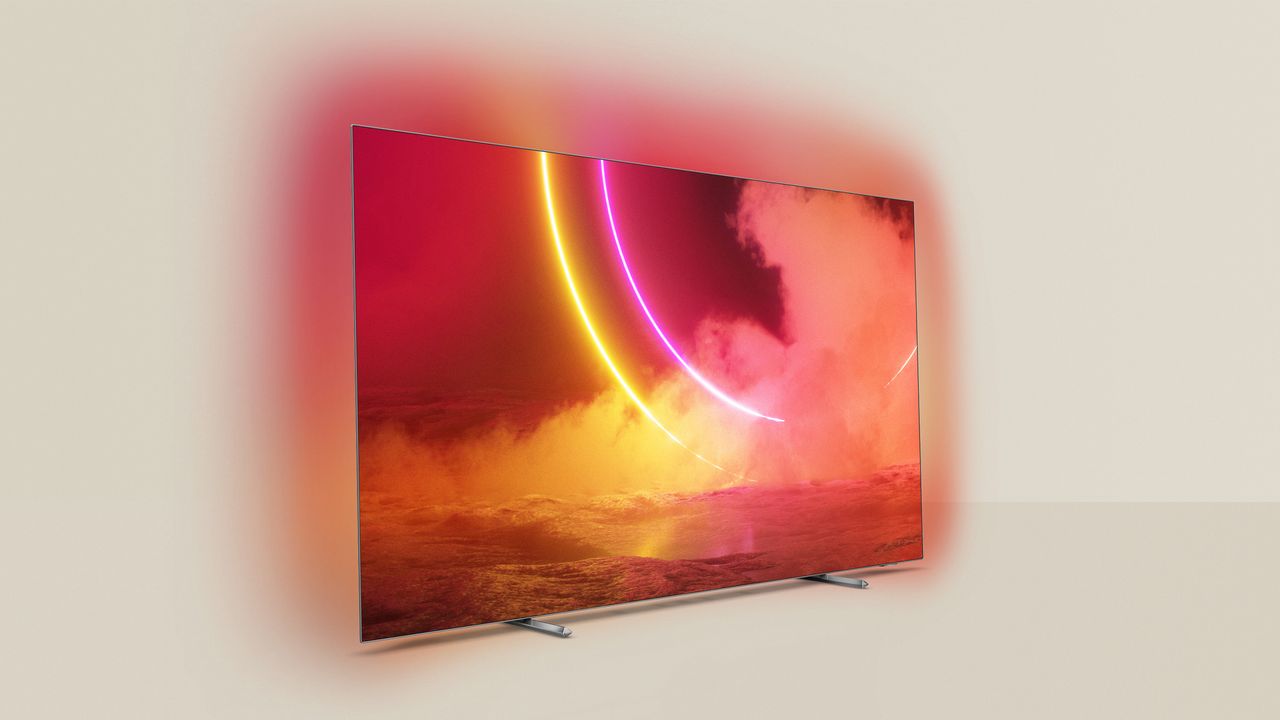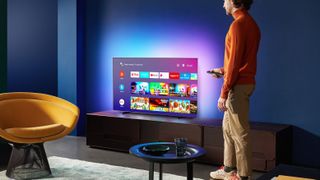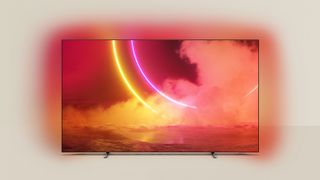Philips OLED805 (65OLED805) review: One of the prettiest and most affordable OLED TVs in town
The Philips OLED805 delivers vibrant images at an excellent price in a spectacular design, but it's not ideal for next-gen gaming


The Philips OLED805 retains the boldness and flair we’ve come to associate with Philips’ OLED picture quality. Its Ambilight-enhanced design and price at 65 inches are supremely impressive too. Next-gen gamers may rue the lack of support for variable refresh rates and 4K at 120Hz, and it's a shame there's no eARC support.
-
+
Vibrant and detailed pictures
-
+
Spectacular design and build quality
-
+
Good value for what’s on offer
-
-
No VRR or 4K at 120Hz gaming support
-
-
No eARC audio passthrough
-
-
Small chance of permanent image retention (as with all OLED TVs)
Why you can trust T3

The Philips OLED805 continues to hold its own in the raging OLED price war. Those hunting for the truly vibrant imagery of OLED panels are still looking at significant outlays to ensure their pixel hungry desires are met, but it's getting heated out there.
The best OLED TVs – which make up a lot of best TVs overall, of course – are a hotbed of competition among the biggest brands, competing to deliver the best visual images, best design and, importantly, at a competitive price. The Philips OLED805 enters the market as a perfect combination of all three.
- Breaking! iPhone 12 benchmarks just SMOKED every other phone you can buy
- Potential Google Pixel 5 flaw might make you think twice about buying one
- iPhone 12 battery life test results confirm our worst fears
- iPhone 12 ridiculed by Samsung for "most basic" fail
- AirPods Pro 2 leak reveals price and new features
Sadly for our US readers, this TV is available in the UK and Europe only – OLEDs at this price are dominated by the LG CX in the US.
Leaving the cheaper end of the market to the excellent Philips OLED754 (again UK-only – but the US has the Vizio OLED-H1 now) the OLED805 is an exceptional television that has it all and, despite undercutting the LG CX by £100 at the 65-inch size, the Philips 65OLED805 is anything but a compromise.
Its Ambilight-illuminated design is a thing of beauty, and the addition of AI to Philips’ picture processing technology takes the brand’s OLED picture quality to new heights. Add in universal HDR support, and the only real catch is when it comes to gaming.
- See the best gaming TVs
- And the best TVs under £1000
- Or the best TVs under £500
Philips OLED805 review: Price & features
The Philips OLED805 comes in two sizes: the 55-inch 55OLED805 for £1,499, or the 65-inch model we're reviewing here, the 65OLED805.
At £2,199, the 65-inch Philips 65OLED805 is eye-catchingly affordable for a 65-inch OLED TV. The entry level LG 65OLEDBX has recently come out for just £1,799, but that set lacks the processing horsepower of either this Philips set or the £2,299 LG OLED65CX model that the 65OLED805 feels much closer to.
The 65OLED805’s extensive features list does little to suggest that Philips has cut lots of corners to hit its aggressive price. For starters, the simple fact that it’s an OLED TV, where every pixel can produce its own light and colour independent of its neighbours, will immediately warm the cockles of many AV fans.
• OLED vs QLED: how the technologies compare
This is true of all OLED TVs, though. Where the 65OLED805 gets really interesting is in the ways it stands out from the OLED crowd. Starting with the new 4th generation of Philips’ powerful P5 picture engine.
The P5 name refers to what Philips sees as the five main pillars of TV picture quality: source recognition, sharpness, contrast, colour and motion handling. In trying to optimise all of these five key picture quality traits, though, Philips deploys far more than five picture processing elements. In fact there are dozens of them, each applied in the best order to yield the most optimised results.

The new 4th generation of P5 is significantly bolstered by the addition of AI support. This uses knowledge learned by feeding thousands of different images through a neural network to more quickly and accurately identify and categorise incoming image types, enabling the TV to apply the most appropriate processing options in real time.
The system essentially divides everything into five categories: Nature, Face, Motion, Dark and Other. Any images put into the first four of these categories have all-new AI-calculated processing applied to them. Relatively unspecific images that end up in the Other category receive essentially the same (also excellent) processing they would have received on last year’s Philips OLED TVs.
The promising picture features are backed up by a 50W, 2.1-channel audio system that supports Dolby Atmos playback, while Smart features on the 65OLED805 are, as usual with Philips’ premium TVs, provided predominantly by Android TV (Pie). It’s good to see, though, that Philips is finally backing Android TV up in the UK with the Freeview Play platform. This works around Android’s ongoing ‘blind spot’ with certain key UK broadcaster catch up apps. Though it can’t solve Android TV’s current lack of an Apple TV app.
It's also a treat to find that the TV supports both HDR10+ and Dolby Vision HDR premium formats, when most TV brands only support one advanced HDR option or the other.
At first glance the 65OLED805’s connections looks right on the money. Four HDMIs is as many as you’ll find on any TV right now, and two USB ports will be ample for most people (though some TVs provide three). There are the usual Bluetooth and Wi-Fi options, too.
There are, though, also limits to what the 65OLED805’s connections can do. They don’t support eARC, for instance, that might have allowed the set to pass through lossless Dolby Atmos sound via HDMI to soundbars or AVRs.
Nor do they support ‘next-gen’ gaming features such as 4K at 120Hz Variable Refresh Rate, or the Auto Low Latency Mode standard for automatically setting the Game Mode when a console is turned on.
If you manually select the Game mode when using the TV with a console or PC, it reduces the time the OLED65805 takes to produce pictures to just over 33ms. This is an okay result, but we have seen other premium TV brands getting below 15ms.
For those hunting down low latency screens, especially with the release of the new generation of consoles, take a look at our best gaming TVs.

Philips OLED805 review: Picture quality
Philips has long been a trailblazer when it comes to picture processing, leading to its premium TVs consistently producing unusually dazzling colours, contrast and sharpness. At the same time, though, Philips’ processing love-in can cause pictures to look a bit forced and prone to digital noise. Which is where the OLED805’s new AI features come in.
We’re accustomed now to seeing AI features doing impressive things to sharpness and detail – especially when it comes to upscaling HD sources to 4K, or HD/4K to 8K. With the OLED805, though, the AI works across pretty much all aspects of the picture to make the results look more natural. Without, crucially, detracting from Philips’ traditionally aggressive approach.
So, for instance, skin tones are now much more consistently likely to look believable, without saturation levels feeling reduced. There’s more subtle shading in skin tones, too, ensuring people are less likely to end up looking like mannequins.
The AI categorisation means, too, that while the rest of the colour palette still looks bold and punchy, it also looks more balanced and grounded in authenticity. There’s much less likelihood of certain tones ‘shouting out’ above the rest, for instance, or tipping from vibrant into gaudy.
Pictures retain the extreme sharpness and detail Philips is renowned for, but again AI is on hand to ensure that any sharpness processing is applied more intelligently. In other words, it seems to analyse the image in much finer detail, and apply its sharpening and noise control processing in a much more localised way that avoids such issues as grittiness, noise or stressed object edging.
Native 4K and upscaled pictures aren’t perhaps quite as forensically sharp as they have tended to be on some previous Philips TVs, but the results are preferable overall. Especially as the more localised application of sharpening tools makes pictures look more three-dimensional.
Philips has thrown more processing power at removing blur and judder from motion than arguably any other TV manufacturer over the years. But with the OLED805, again, the latest processing reduces the likelihood of this processing causing unwanted motion side effects such as flicker or blurry haloing around moving objects.
An excellent new PureCinema mode, in particular, does a superb job with 24fps films of reducing judder without smoothing the picture to the point where it starts to look like a cheap soap opera.

While the AI features work across all presets apart from Movie (which basically turns almost all of the processing off and actually functions as an ‘as the artist intended’ Filmmaker Mode), there is also a dedicated AI picture mode that gives you more specific controls over how strongly different aspects of the AI system work.
Strangely, though, I found the Standard and Natural presets more effective in their out of the box state than the customisable AI mode. Effective enough, in fact, to make it much less necessary than it ever has been before on a Philips TV to keep heading into the menus to tweak various settings.
All this and I still haven’t mentioned how the OLED805 also benefits from OLED technology’s traditional prowess when it comes to contrast. Dark scenes look black where they should look black, rather than grey or washed out. And bright highlights in dark pictures appear without any of the brightness compromise or surrounding light haloes you get with even the finest LCD TVs.
As a result, while the 750 nits or so of brightness the 65OLED805 can deliver on a white HDR window covering 10% of the screen falls short of the sort of numbers LCD TVs can achieve, the set’s local contrast ensures that contrast-rich HDR images still look phenomenally intense.
The 65OLED805 also delivers full-screen bright HDR shots with a surprising amount of brightness for an OLED screen – yet still delivers that extra ‘kick’ to the very brightest parts of images that helps separate the HDR men from the boys.
There are one or two relatively small flaws to report. Dark but detailed shots can very occasionally reveal faint vertical bands in the picture. Very dark shots can lose a little shadow detail too, though again this issue really is pretty rare/minor, and tends to disappear when using a Dolby Vision source.
Next, the OLED805’s noise reduction systems can be a little enthusiastic (especially when using the HDR AI preset) despite the new AI assistance, sometimes softening 4K sources to the point where they lose noticeable amounts of sharpness and detail. So don’t be afraid to set the NR systems to minimum or even turn them off with native 4K. Though turning them off completely arguably slightly messes with the overall picture balance Philips’ suite of AI enhancements is trying to create.
As with any OLED TV, finally, it’s recommended that you take care over what you watch on the OLED805 in order to minimise the small potential for the screen to suffer permanent image retention. This essentially means trying not to spend excessive amounts of time watching TV channels or games that have bright static logos or HUDs.

Philips OLED805 review: Sound quality
The 65OLED805 sounds better than it has any right to given its super-trim design. Especially if you’re not wall hanging it, and so can leave a few centimetres between the screen’s rear and your wall so that its three large rear-mounted drivers have room for manoeuvre.
Sound is cast well beyond the left and right edges of the TV’s chassis, creating a powerful and immersive wall of sound. There’s plenty of well-placed detail within this horizontal splay too, and the sound has a surprisingly forward feeling to it for a TV that has no forward firing speakers. Voices are delivered with both clarity and context, and while bass isn’t particularly meaty, it’s present enough to make the sound stage feel quite dynamic, and sounds clean and distortion-free.
There isn’t as much verticality to the sound as I’d ideally have heard from a Dolby Atmos TV, but maybe this is just a case of the 65OLED805 sensibly accepting its limitations.

Philips OLED805 review: Design & usability
The OLED805 is a seriously good looking TV. Way better looking than you’d expect given its price, in fact. The frame around the screen is extremely trim, and the outer edges of the rear panel are only a handful of millimetres deep. The main panel boasts a gorgeous brushed metallic finish, too.
The OLED805 carries a chunky black plastic protruberance over around two thirds of its rear, but you can’t see this from all but the most extreme viewing angles. It’s easy to forgive this chunky bit, too, when you realise that it houses both the OLED805’s unexpectedly powerful speaker system, and the LEDs necessary to deliver Philips’ unique Ambilight technology.
Ambilight casts coloured light out from the TV’s edges that can either be set to a single colour for bias lighting purposes, or to dynamically track the colour content and brightness of the images you’re watching. This sounds gimmicky, but actually, provided you run the feature at a fairly low brightness level and mild level of ‘responsiveness’, it’s almost uncannily effective at making the image even more immersive.
The OLED805’s screen sits on a pair of ultra minimalist metal feet that are really just crisp silver bars you can barely see when watching the TV straight on. In its standard configuration, the OLED805’s screen sits right down on these feet, further minimising their design impact. Handily, though, Philips provides a pair of feet ‘heighteners’ that can raise the screen up for people wanting to use the TV with a soundbar.
As mentioned briefly earlier, the OLED805’s new AI features make it considerably easy to get the best out of than previous generations of Philips TV. There’s much less need to keep revisiting the onscreen menus. That said, the menus are still dense, multi-layered and complicated when you do decide to engage with them.
I personally still find the Android TV smart system less friendly than most rival systems. It’s not as customisable as some, for instance, and the way the home menu takes over the whole screen feels old fashioned. It also takes a quantity-over-quality approach to apps. It is at least much less prone to sluggishness and crashes than it used to be, though.

Philips OLED805 review: Verdict
The addition of AI technology to the OLED805 proves a masterstroke, finally enabling Philips to deliver pleasingly aggressive processing to pictures without the results actually looking processed.
The fact that the OLED805 is also one of the prettiest and OLED TVs in town and is well-priced is just the icing on the cake.
For those who aren't concerned about next-gen gaming features, but would like hugely immersive movies that don't require any effort to get to peak quality (thanks to the AI processing), the Philips OLED805 is ideal.
Philips OLED805 review: Also consider
The main competitor at this price point is the LG CX, which is almost identical in price to the OLED805 at the same sizes – though the 65-inch OLED805 is a little cheaper. The LG CX offers the next-gen gaming features that this lacks, and is similarly impressive in image detail. However, the OLED805's speaker quality and its Ambilight feature go towards balancing that out. Our full LG CX review explains why we like that TV so much.
You might also like the LG BX as an option, if you want to save a bit of money, or put some money towards a soundbar. It's a little less bright than the OLED805, and with less advanced processing, but is still an OLED screen with supreme rich black levels and stunning colours. Like the LG CX, it's equipped with all the next-gen gaming features.
- The best 32-inch TVs – perfect for bedrooms and offices
- The best 43-inch TVs – great entry-level 4K sets
- The best 48- to 50-inch TVs – beautiful mid-size 4K TV sets
- The best 55-inch TVs – premium TVs that still fit most living rooms
- The best 65-inch TVs – beautiful big-screen TVs
- The best 75-inch TVs – giant 4K and 8K TVs packed with features
Sign up to the T3 newsletter for smarter living straight to your inbox
Get all the latest news, reviews, deals and buying guides on gorgeous tech, home and active products from the T3 experts
John Archer has been testing TVs and AV gear for over 25 years, having worked on Home Cinema Choice magazine. He's a contributor to Forbes, TechRadar, Trusted Reviews, Wired and many more places – if you've owned a TV in the last couple of decades, John's probably reviewed it somewhere. He's seen so many hot new technologies come and go, like tears in the rain.
-
 A Pilates teacher says these five exercises are the best place to start for building a stronger, resillient body
A Pilates teacher says these five exercises are the best place to start for building a stronger, resillient bodyLooking for a more gentle approach to toning and strengthening your body? This Pilates workout offers just that
By Bryony Firth-Bernard Published
-
 Marvel's 99% rated show is to return – 10 years after breakthrough original
Marvel's 99% rated show is to return – 10 years after breakthrough originalDaredevil has been gone for way too long
By Max Freeman-Mills Published
-
 Ultrahuman sees red with bold move into cardiovascular health
Ultrahuman sees red with bold move into cardiovascular healthNew InsideTracker partnership puts heart health front and centre
By Matt Kollat Published